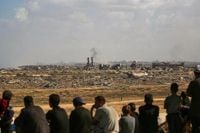On October 10, 2025, a long-awaited ceasefire took effect in Gaza, bringing a tentative end to two years of devastating war between Israel and Hamas. The agreement, brokered by U.S. President Donald Trump, prompted Israeli forces to begin a phased withdrawal from the battered enclave, while thousands of displaced Palestinians streamed northward, hoping for a glimpse of what remained of their former homes.
As Israeli troops halted fire at noon, families—many barefoot or pushing bicycles piled high with salvaged belongings—walked the coastal highway toward Gaza City. The city, once a vibrant urban center, now stood as a symbol of destruction, its neighborhoods flattened by bombing campaigns and its streets littered with the remnants of daily life. To the south, residents picked through the pulverized remains of Khan Younis, Gaza’s second-largest city, reduced to dust and twisted metal by the relentless conflict.
The ceasefire, which came into force at noon local time, marked the first significant step in a sweeping 20-point peace plan announced by President Trump earlier in the week. According to BBC, the Israeli military confirmed that troops had completed the first phase of their pullback just three hours after the ceasefire began, though they still held about 53 percent of the territory. The deal set a 72-hour deadline for Hamas to release the remaining 47 hostages from the 251 abducted during the deadly attacks of October 7, 2023—a day that saw 1,200 Israelis and foreigners killed and the region plunged into chaos.
Israel, in turn, published lists of 250 Palestinian prisoners and 1,700 Gazans it planned to release as part of the exchange. The Israeli Justice Ministry specified that released prisoners would be deported to Gaza or other locations, barred from returning to Israel or the occupied West Bank. The handover of living hostages is expected to begin on Monday, October 13, 2025, as drills with actors at a hospital outside Tel Aviv prepared staff for their arrival, reported NBC News.
The humanitarian toll of the conflict has been staggering. Gaza’s health authorities said recovery teams had pulled more than 100 bodies from the rubble since the Israeli army began pulling back. Over the course of the war, at least 67,000 Palestinians—many of them women and children—have lost their lives, according to Gaza’s health ministry. The United Nations determined last month that Israel had committed genocide in Gaza, a characterization Israel firmly rejects. The war also left deep scars in Israel, where the October 7 attack remains a national trauma.
For many Gazans, the return was bittersweet. “We went back to our area—it was exterminated,” Ahmed al-Brim told Reuters, pushing a bicycle stacked with scraps of timber. “We couldn’t find furniture or clothes. Not even winter clothes. Nothing is left.” Another resident, Mahdi Saqla, expressed a quiet resilience: “Our homes are gone. But we are happy to stand again where our homes once stood—even if it’s just over rubble. That, too, is a kind of joy.”
Palestinian residents have been massing near Gaza City, desperate to see what remains of their homes. “I feel reborn,” said Mohammad Rajab, 33. “Despite all the sadness and the huge destruction, we are looking ahead and thinking about how we will build our lives, our future, our children’s future, and rebuild everything that was destroyed and move away from war.”
The ceasefire was ratified by the Israeli government in the early hours of Friday. Under the agreement’s first phase, Israeli troops are required to withdraw from urban areas within 24 hours, retreating to a buffer zone but retaining control over more than half of Gaza for now. Israeli Prime Minister Benjamin Netanyahu confirmed the ceasefire but cautioned that Israel would maintain a presence until Hamas is fully disarmed. “If Hamas disarms, peace will come the easy way. If not, it will come the hard way,” Netanyahu warned in a televised statement. Brigadier General Effie Defrin urged Gazans to respect the agreement and avoid entering areas still under Israeli control.
President Trump, meanwhile, expressed confidence that the truce would hold, calling it a “turning point” and “a consensus on the next steps.” He is scheduled to travel to the Middle East next week, planning to address Israel’s parliament—the Knesset—in Jerusalem, becoming the first American president to do so since 2008. Trump is also expected to visit Egypt, where an international summit on Gaza’s reconstruction will convene, with world leaders in attendance. His plan envisions the creation of a “Board of Peace,” chaired by himself and including former British Prime Minister Tony Blair, to oversee Gaza’s post-war administration and reconstruction. However, Hamas has rejected any form of “foreign guardianship,” insisting that Gaza’s governance “remains a purely Palestinian matter.”
The U.S. is preparing to deploy as many as 200 troops to Israel to support the flow of humanitarian aid into Gaza, but American soldiers will not enter the enclave itself. Other countries expected to contribute troops include Egypt, Qatar, Turkey, and the United Arab Emirates, with the U.S. Central Command establishing a civil-military coordination center for aid movement. The European Union’s top diplomat, Kaja Kallas, stated that an EU humanitarian team stands ready at Egypt’s Rafah border crossing to facilitate the delivery of food, fuel, and medical aid—urgently needed in a region where famine has been declared due to Israeli restrictions on supplies.
In the United States, the ceasefire and troop withdrawal sparked demonstrations of solidarity. On Friday night, supporters gathered outside the San Francisco Federal Building, calling for an arms embargo at Oakland San Francisco Bay Airport to halt military shipments to Israel. “We want to make sure that if there’s going to be a ceasefire, it can actually stay and Palestinians can maintain their right to live in peace and dignity. And for that reason we’re continuing our fight for an arms embargo in Oakland,” said Irom, a rally attendee. The airport responded that, as a federally regulated public facility, it is legally required to accommodate authorized air traffic, including cargo arranged by the U.S. government.
Despite the breakthrough, many crucial questions remain unresolved. Who will govern Gaza after the war? Will Hamas agree to disarm? How will reconstruction proceed amid the ruins? The Hamas-run interior ministry has said it will redeploy local security forces in areas vacated by Israeli troops, though it is unclear if armed militants will return to the streets—a move that could quickly reignite hostilities. For now, Gaza’s weary residents are taking tentative steps toward normalcy, uncertain how long the calm will last.
As the world watches, the people of Gaza and Israel stand at a crossroads—caught between the hope of peace and the shadow of a conflict that has left deep wounds on both sides. The coming days will reveal whether this fragile ceasefire can hold, and whether the region can begin the long, painful process of healing and rebuilding.

